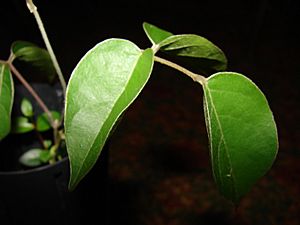Molokai Jack-bean facts for kids
Quick facts for kids Molokai Jack-bean |
|
|---|---|
 |
|
| Conservation status | |
| Scientific classification | |
| Kingdom: | |
| (unranked): | |
| (unranked): | |
| (unranked): | |
| Order: | |
| Family: | |
| Genus: |
Canavalia
|
| Species: |
C. molokaiensis
|
| Binomial name | |
| Canavalia molokaiensis O.Deg., I.Deg. & J.D.Sauer
|
|
The Canavalia molokaiensis, often called the Molokaʻi Jack-bean or puakauhi, is a very rare flowering plant. It belongs to the Fabaceae family, which is also known as the pea or legume family. This special plant grows only on the island of Molokaʻi in Hawaii. Other similar plants in Hawaii are known as ʻāwikiwiki.
Contents
About the Molokaʻi Jack-bean
What it Looks Like
The Molokaʻi Jack-bean is a type of vine. It has beautiful red-purple flowers that look like peas. This plant is unique to Molokaʻi.
Where it Lives
This plant likes to grow on exposed, steep cliffs. These cliffs are found in dry and "mesic" (meaning moderately wet) forests. The forests where it lives are mostly filled with ʻōhiʻa lehua trees (Metrosideros polymorpha) and ʻaʻaliʻi shrubs (Dodonaea viscosa). You can find these plants at high elevations. They grow about 850 to 930 meters (2,790 to 3,050 feet) above sea level.
Plant Neighbors
Other plants that grow near the Molokaʻi Jack-bean include ʻāhinahina (Artemisia species). You might also see ʻakoko (Euphorbia species) and pilo (Coprosma species). Pūkiawe (Styphelia tameiameiae) and ʻākia (Wikstroemia species) are also common neighbors.
Why the Molokaʻi Jack-bean is in Danger
This rare plant faces many threats. Its home is being destroyed, mainly because of animals that were brought to the island. These animals, like goats or pigs, eat the plants and damage their habitat.
Small Populations
There are only a few groups of Molokaʻi Jack-bean plants left. Scientists have found only four main populations. In total, there are about 200 to 500 individual plants. Sometimes, this is seen as one large group that has been broken into smaller pieces. This is called habitat fragmentation.
Other Threats
Another big problem comes from introduced plant species. These are plants that are not native to Hawaii. They can grow very fast and take over the space where the Molokaʻi Jack-bean needs to live. This makes it harder for the native plant to survive.
Legal Protection
Because it is so rare and threatened, the Molokaʻi Jack-bean has been protected by law. It has been listed as a federally endangered species in the United States since 1992. This means it is against the law to harm these plants or their habitat.


